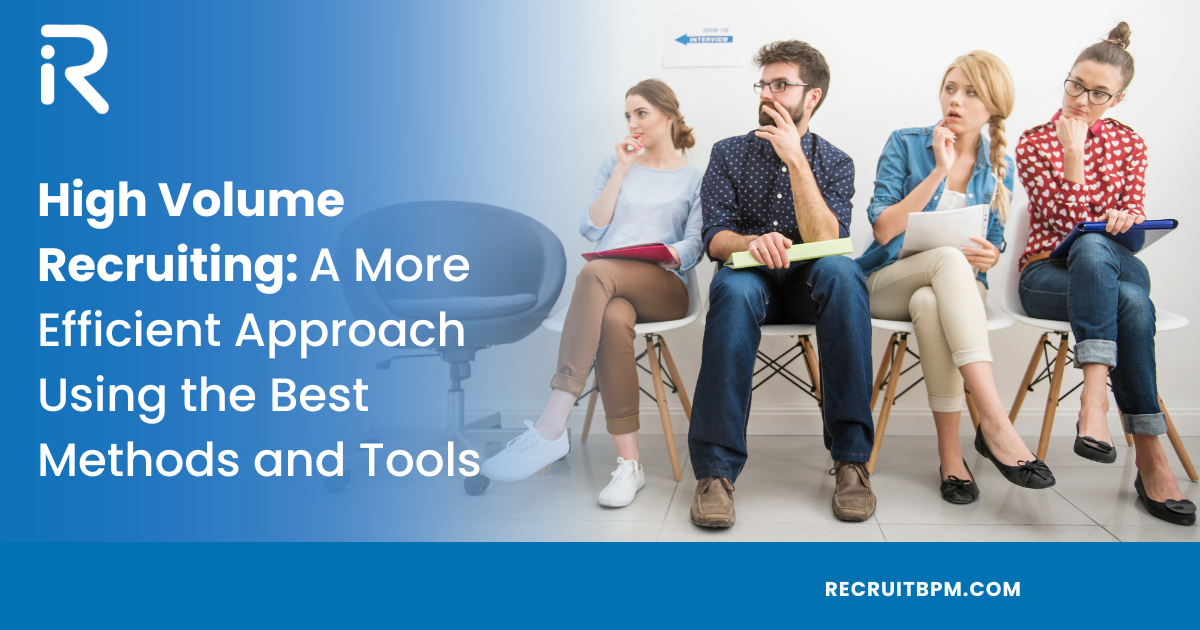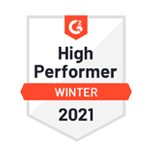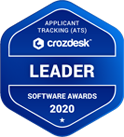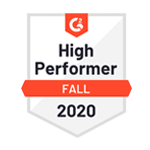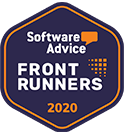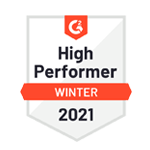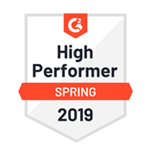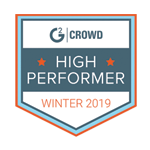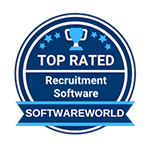High-volume recruiting transforms how companies approach massive hiring needs. Whether you’re staffing for seasonal peaks or scaling rapidly, this comprehensive guide provides proven strategies for success. Learn how to hire hundreds or thousands while maintaining quality standards.
What is High-Volume Recruiting?
High-volume recruiting means hiring large numbers of employees within compressed timeframes. This specialized approach fills multiple similar positions simultaneously across locations or departments. Companies typically need this when hiring 50+ employees within 90 days.
The process demands different tactics than traditional hiring. Speed becomes critical without sacrificing candidate quality or experience. Organizations must process hundreds of applications daily while maintaining consistent evaluation standards. Automation and technology become essential tools rather than optional enhancements.
Key characteristics include accelerated timelines and streamlined processes. Bulk hiring campaigns focus on efficiency through standardized workflows. Teams handle multiple requisitions simultaneously while tracking numerous candidates through various stages. Success requires balancing quantity with quality throughout recruitment.
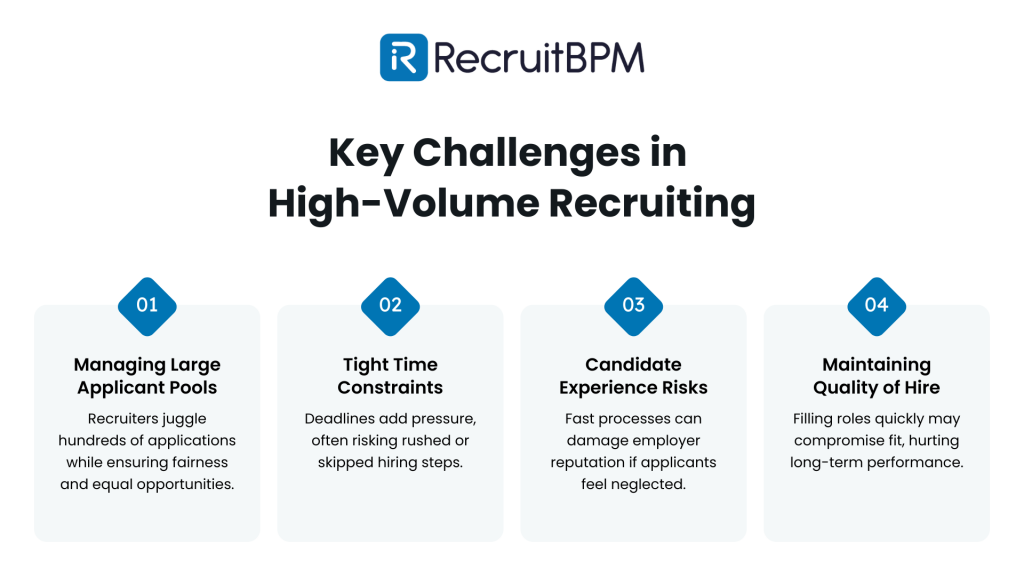
High-Volume Recruiting vs. Traditional Recruiting
Traditional recruiting focuses on individual positions with specialized requirements. Recruiters spend weeks finding perfect matches for specific roles. Each candidate receives personalized attention throughout extended evaluation periods. Hiring managers conduct multiple rounds of detailed interviews.
High-volume recruiting operates completely differently. Teams fill numerous similar positions using standardized processes. Automation handles repetitive tasks while maintaining candidate engagement. Recruiters focus on managing workflows rather than individual relationships. Technology screens applications while humans make final decisions.
The fundamental difference lies in scale and approach. Traditional recruiting emphasizes depth over breadth in candidate evaluation. High-volume recruiting prioritizes efficient processing without losing effectiveness. Both methods serve important purposes depending on organizational needs.
Industries That Rely on High-Volume Hiring
Retail leads high-volume hiring with seasonal workforce expansions. Holiday shopping seasons require tripling staff within weeks. Store openings demand immediate staffing across multiple departments. Annual turnover rates exceeding 60% create continuous hiring needs.
Healthcare organizations constantly recruit nurses and support staff. Hospitals fill hundreds of positions across multiple shifts. Medical facilities experience a 20% annual turnover, requiring ongoing recruitment. Expansion into new communities demands rapid workforce development.
Manufacturing and warehousing face similar challenges with distribution centers. E-commerce growth drives continuous facility expansions requiring thousands of workers. Seasonal peaks like Prime Day need temporary workforce surges. Third-shift operations create additional staffing complexities requiring specialized approaches.
Customer service centers hire continuously for high-turnover positions. Call centers onboard entire teams for new client contracts. Technical support departments scale with product launches and updates. Remote work expansion creates new geographic hiring opportunities.
When Do You Need High-Volume Recruiting?
Seasonal businesses experience predictable workforce fluctuations requiring strategic planning. Retailers prepare for November-December peaks starting in September. Tax preparation firms ramp up from January through April. Tourism and hospitality surge during the summer months.
Planning seasonal hiring requires analyzing previous years’ patterns. Calculate peak staffing needs based on sales projections. Factor in training time when determining recruitment start dates. Build talent pipelines, maintaining contact with previous seasonal workers.
Successful seasonal recruiting starts months before actual needs. Create evergreen job postings accepting year-round applications. Maintain warm candidate pools through regular communication. Develop relationships with schools for student worker programs.
Rapid Business Growth and Expansion
Startups securing funding often need immediate team scaling. Series A companies typically double headcount within six months. Successful product launches trigger urgent hiring across departments. Market expansion requires establishing entirely new regional teams.
Growth hiring differs from seasonal needs through a permanent position focus. Companies build long-term teams rather than temporary workforces. Cultural fit becomes crucial when rapidly expanding organizations. Onboarding processes must scale without losing effectiveness.
Planning for growth requires a flexible recruiting infrastructure. Establish scalable processes before receiving funding or contracts. Build relationships with recruiting agencies for surge capacity. Create employee referral programs leveraging existing team networks.
New Location or Department Launches
Opening new facilities demands coordinated multi-department hiring efforts. Manufacturing plants hire 500+ employees before production begins. Retail chains staff entire stores within 30-day windows. Corporate expansions require building complete regional offices.
Location-based hiring presents unique logistical challenges requiring local expertise. Research regional labor markets, understanding competitive wages and availability. Partner with local organizations, including schools and workforce centers. Customize recruitment messaging highlighting community involvement and opportunities.
Timeline management becomes critical for facility launches. Work backwards from the opening date,s determining hiring milestones. Account for background checks and drug screening timeframes. Plan orientation and training schedules accommodating large groups.
High Turnover Industries
Some industries face perpetual hiring due to structural factors. Food service experiences 75% annual turnover rates. Transportation companies constantly recruit drivers amid shortages. Hospitality struggles with retention despite competitive wages.
High-turnover recruiting requires different strategic approaches than expansion hiring. Focus on reducing turnover while maintaining hiring pipelines. Analyze exit data, identifying preventable departure reasons. Implement retention programs addressing common pain points.
Continuous hiring demands sustainable recruiting processes, avoiding team burnout. Automate routine tasks, freeing recruiters for relationship building. Create talent communities, maintaining engagement with potential candidates. Develop “always-on” recruiting strategies, preparing for inevitable departures.
Top 7 Challenges of High-Volume Recruiting
Processing hundreds of daily applications overwhelms traditional review methods. Recruiters spend hours screening resumes, missing qualified candidates. Important applications get lost in email floods. Response delays cause top talent to accept competitor offers.
Volume management requires systematic approaches beyond manual review. Implement applicant tracking systems and organize candidate flow. Create knockout questions, eliminating unqualified applicants immediately. Use keyword filtering to identify candidates meeting minimum requirements.
Smart volume management improves both efficiency and outcomes. Set realistic review timelines, communicating them to applicants. Batch similar applications for comparative evaluation sessions. Delegate initial screening to junior team members or technology.
Maintaining Quality of Hire at Scale
Speed pressures often compromise hiring standards during volume recruiting. Rushed decisions lead to poor cultural fits. Inadequate screening results in performance issues. High early turnover indicates quality problems.
Quality maintenance requires disciplined processes resisting shortcut temptations. Define non-negotiable requirements before starting recruitment. Create standardized evaluation criteria, ensuring consistency. Track quality metrics, identifying process weaknesses.
Successful organizations balance speed with thoroughness strategically. Invest in pre-employment assessments validating critical skills. Conduct structured interviews focusing on essential competencies. Monitor new hire performance, confirming selection effectiveness.
Time Constraints and Speed Requirements
Compressed timelines create intense pressure throughout recruiting teams. Positions must be filled before competitors capture candidates. Training schedules dictate inflexible start dates. Business needs don’t accommodate recruitment delays.
Time management becomes crucial for meeting aggressive deadlines. Eliminate process bottlenecks slowing candidate progression. Reduce interview rounds without sacrificing evaluation quality. Accelerate offer approval through pre-negotiated parameters.
Technology accelerates time-consuming recruiting activities significantly. Automated scheduling eliminates calendar coordination delays. Digital assessments provide immediate scoring and feedback. Video interviews enable asynchronous candidate evaluation.
Candidate Experience and Engagement
High-volume processes often feel impersonal to candidates. Automated responses lack human connection. Long silences leave applicants wondering about their status. Poor experiences damage employer’s brand reputation.
Maintaining positive experiences requires intentional design despite scale. Communicate clear expectations about process timelines. Provide regular updates even without final decisions. Personalize communications using candidate names and details.
Technology enhances rather than replaces human interaction. Chatbots answer common questions 24/7. Self-scheduling tools give candidates control. Mobile applications meet candidates where they are.
Resource and Budget Limitations
Limited budgets constrain technology investments and team expansion. Small recruiting teams handle enterprise-level hiring volumes. Inadequate tools force manual workarounds. Cost pressures demand doing more with less.
Resource optimization requires strategic prioritization and creativity. Focus spending on the highest-impact tools and channels. Leverage free resources like social media. Partner with community organizations to extend reach.
Smart resource allocation multiplies team effectiveness significantly. Automate repetitive tasks, freeing recruiter time. Outsource specialized functions like background checks. Use employee referrals to reduce sourcing costs.
Diversity and Compliance Issues
Large-scale hiring risks perpetuating bias through standardized processes. Rushed decisions rely on gut feelings over objective evaluation. Limited sourcing reproduces existing demographic patterns. Compliance requirements add complexity without adding value.
Diversity requires intentional effort throughout volume recruiting. Expand sourcing channels reaching underrepresented communities. Remove bias-triggering information from initial screening. Train interviewers in recognizing unconscious preferences.
Compliance becomes more challenging with increased scale. Document consistent application of selection criteria. Monitor adverse impact across protected classes. Maintain required records despite volume pressures.
Technology and Process Scalability
Existing systems break under high-volume demands. Manual processes can’t scale to meet surge needs. Disconnected tools create data silos. Technical limitations force process compromises.
Scalability requires infrastructure supporting peak rather than average loads. Choose cloud-based systems handling variable demand. Integrate tools, eliminating duplicate data entry. Build processes assuming 10x current volume.
Future-proofing technology investments prevents repeated system replacements. Select vendors with proven high-volume capabilities. Prioritize APIs enabling tool integration. Design modular processes accommodating changing needs.
9 Proven High-Volume Recruiting Strategies
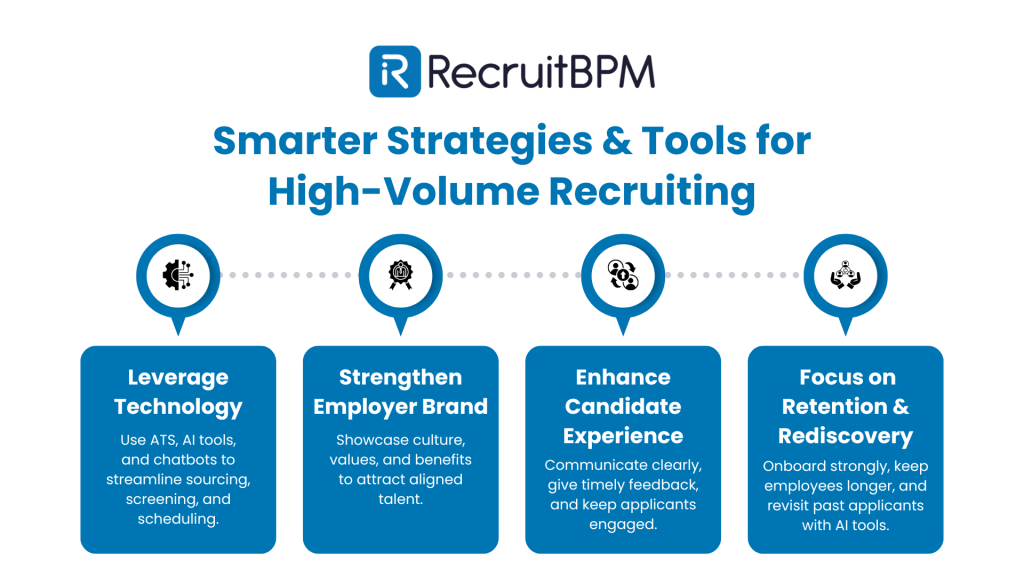
1. Implement Smart Automation and AI Tools
Automation transforms high-volume recruiting from overwhelming to manageable. AI screens resumes, identifying qualified candidates instantly. Chatbots engage applicants by answering questions immediately. Workflow automation moves candidates through stages automatically.
Smart automation goes beyond simple keyword matching. Machine learning identifies successful employee patterns. Natural language processing understands resume context. Predictive analytics forecasts candidate success probability.
Implementation requires thoughtful planning, avoiding over-automation. Maintain human touchpoints at critical moments. Test automation rules preventing qualified candidate exclusion. Monitor automation effectiveness, adjusting parameters regularly.
Start with the highest-impact automation opportunities first. Resume screening saves hours of manual review. Interview scheduling eliminates back-and-forth coordination. Status updates keep candidates informed automatically.
2. Optimize Your Application Process
Complex applications deter qualified candidates from completing submissions. Long forms cause 60% abandonment rates. Mandatory account creation adds unnecessary friction. Desktop-only applications exclude mobile candidates.
Optimization starts with ruthless simplification, removing unnecessary fields. Collect essential information only during the initial application. Request additional details from advancing candidates. Allow resume parsing to populate forms automatically.
Mobile optimization becomes mandatory, not optional. Design mobile-first application experiences. Test applications across devices, ensuring functionality. Enable one-click apply through job board integrations.
Measure application metrics, identifying improvement opportunities continuously. Track abandonment points showing where candidates quit. A/B test form variations to improve completion rates. Monitor time-to-complete, ensuring reasonable expectations.
3. Build Talent Pipelines Before You Need Them
Reactive recruiting creates unnecessary urgency and pressure. Proactive pipeline building provides ready candidate pools. Continuous engagement maintains candidate interest. Warm leads convert faster than cold sourcing.
Pipeline development requires year-round recruitment marketing efforts. Create talent communities around career interests. Share valuable content, keeping candidates engaged. Host virtual events, building employer brand.
Segment pipelines based on role types and locations. Maintain separate pools for different skill sets. Track pipeline health monitoring engagement levels. Re-engage dormant candidates, preventing pipeline decay.
Technology enables scalable pipeline management processes. CRM systems track candidate relationships over time. Marketing automation nurtures candidates until they are ready. Analytics identify optimal engagement frequencies and content.
4. Leverage Multiple Sourcing Channels
Single-source dependency creates vulnerability and limits reach. Diversified sourcing improves candidate quality and quantity. Different channels attract different candidate demographics. Multi-channel strategies reduce cost-per-hire significantly.
Effective sourcing combines active and passive channels strategically. Job boards generate immediate application volume. Social media reaches passive candidates. Employee referrals provide pre-vetted candidates.
Channel selection depends on role requirements and budgets. Free channels like organic social require time investment. Paid channels deliver faster results. Niche boards target specific skill sets.
Performance tracking optimizes channel investment continuously. Measure applications, interviews, and hires by source. Calculate cost-per-hire across channels. Adjust spending based on channel effectiveness.
5. Create Efficient Screening Workflows
Manual screening doesn’t scale with application volume. Inefficient workflows create bottlenecks, delaying decisions. Inconsistent evaluation leads to poor hiring outcomes. Delayed screening causes candidate drop-off.
Efficient workflows combine technology and human judgment. Knockout questions eliminate obviously unqualified candidates. Skills assessments validate claimed competencies. Phone screens verify communication abilities.
Standardization ensures consistent candidate evaluation. Create screening scorecards defining evaluation criteria. Train screeners to apply standards uniformly. Calibrate ratings, ensuring inter-rater reliability.
Continuous improvement refines screening effectiveness. Analyze screening scores against performance. Identify questions predicting success. Eliminate steps that do not improve selection.
6. Use Structured Interview Processes
Unstructured interviews produce inconsistent, biased results. Different interviewers ask different questions. Subjective impressions override objective qualifications. Comparison becomes impossible across candidates.
Structured interviews improve selection accuracy dramatically. Predetermined questions ensure comprehensive evaluation. Behavioral questions predict future performance. Rating scales quantify subjective impressions.
Implementation requires upfront investment yielding long-term benefits. Develop question banks for different roles. Train interviewers on structured techniques. Create evaluation forms capturing standardized feedback.
Technology supports structured interview scaling. Video interviews enable asynchronous evaluation. Digital scorecards aggregate interviewer feedback. Analytics identify the most predictive questions.
7. Enable Employee Referral Programs
Employees represent untapped recruiting resources. Referrals produce higher-quality hires. Referred candidates accept offers more frequently. Referral hires demonstrate better retention.
Successful programs make referring easy and rewarding. Simplify referral submission processes. Provide referral status updates. Offer meaningful incentives to motivate participation.
Promotion drives program awareness and participation. Communicate open positions regularly. Share referral success stories. Recognize top referrers publicly.
Technology streamlines referral program administration. Referral platforms track submissions automatically. Analytics identify the most effective referrers. Automation handles incentive payments.
8. Develop Clear Communication Templates
Inconsistent communication confuses candidates and damages the brand. Delayed responses cause candidate frustration. Poor communication leads to offer declines. Manual communication doesn’t scale.
Templates ensure consistent, professional communication. Create templates for common scenarios. Customize templates, maintaining a personal touch. Translate templates for multilingual candidates.
Automation delivers timely communication at scale. Configure automatic status updates. Schedule interview reminders. Send offer letters immediately upon approval.
Measurement improves communication effectiveness continuously. Track email open and response rates. Survey candidates about communication satisfaction. A/B test message variations.
9. Focus on Data-Driven Decision Making
Gut-feel decisions don’t scale or improve. Anecdotal evidence misleads strategic planning. Unmeasured processes can’t be optimized. Data reveals hidden problems and opportunities.
Data-driven recruiting requires systematic measurement. Define key performance indicators. Implement tracking mechanisms. Create regular reporting cadences.
Analytics transform data into actionable insights. Identify bottlenecks slowing hiring. Compare recruiter performance objectively. Predict future hiring needs.
Continuous improvement depends on data-driven experimentation. Test process changes, measuring impact. Compare strategies across locations. Scale successful experiments enterprise-wide.
Essential Technology for High-Volume Recruiting
Applicant Tracking Systems (ATS) for Scale
Modern ATS platforms handle thousands of simultaneous applicants. Cloud-based systems scale with demand automatically. Integration capabilities connect disparate tools. Analytics provide real-time visibility into pipeline health.
Selection criteria should prioritize scalability and usability. Evaluate peak load handling capabilities. Test user interface intuitiveness. Verify integration with existing systems.
Implementation success requires careful planning and training. Migrate historical data, maintaining continuity. Configure workflows matching existing processes. Train users, ensuring adoption.
Leading platforms include Greenhouse, Lever, and iCIMS. Each offers different strengths and pricing models. Some excel at enterprise features. Others focus on user experience.
AI-Powered Screening Tools
Artificial intelligence revolutionizes resume screening accuracy and speed. Machine learning identifies qualified candidates missed by keywords. Natural language processing understands context and nuance. Predictive analytics forecasts candidate success probability.
AI screening reduces bias while improving outcomes. Algorithms ignore demographic information. Evaluation focuses on skills and experience. Consistency eliminates subjective preferences.
Implementation requires careful configuration and monitoring. Train models using successful employee data. Test algorithms preventing discriminatory outcomes. Monitor performance, adjusting parameters regularly.
Popular solutions include HireVue, Pymetrics, and Paradox. Each uses different AI approaches. Some focus on video assessment. Others emphasize gamification.
Automated Interview Scheduling
Manual scheduling wastes hours coordinating calendars. Back-and-forth emails frustrate candidates. Double-bookings disrupt interview plans. Time zone confusion causes missed meetings.
Automation eliminates scheduling friction completely. Candidates self-select convenient times. Calendar integration prevents conflicts. Automatic reminders reduce no-shows.
Features should include multi-interviewer coordination. Support panel interview scheduling. Enable recurring availability settings. Provide rescheduling flexibility.
Leading tools include Calendly, GoodTime, and ModernLoop. Integration capabilities vary significantly. Some specialize in complex scheduling. Others prioritize simplicity.
Candidate Relationship Management (CRM)
CRM systems nurture passive candidates long-term. Talent pools stay warm between campaigns. Targeted communications maintain engagement. Analytics track pipeline health.
CRM extends beyond basic contact management. Segmentation enables targeted messaging. Automation scales relationship building. Analytics measure engagement effectiveness.
Selection should prioritize integration and usability. Verify ATS compatibility. Evaluate automation capabilities. Test user interface design.
Top platforms include Beamery, Avature, and SmashFly. Each offers unique strengths. Some excel at recruitment marketing. Others focus on pipeline analytics.
Assessment and Testing Platforms
Assessments validate skills beyond resume claims. Cognitive tests predict job performance. Personality assessments indicate cultural fit. Skills tests confirm technical abilities.
Platform selection depends on role requirements. Customer service needs different assessments than warehouse work. Technical roles require coding tests. Leadership positions need personality assessments.
Implementation requires validation, ensuring effectiveness. Correlate scores with performance. Monitor adverse impact. Adjust cutoff scores appropriately.
Leading providers include Criteria, Indeed Assessments, and SHL. Each offers different test libraries. Some provide custom assessment development. Others focus on standard batteries.
Key Metrics and KPIs for High-Volume Recruiting
Time-to-Hire and Time-to-Fill
Time-to-hire measures days from application to acceptance. Average high-volume time-to-hire runs 14-21 days. Best-in-class organizations achieve 7-10 days. Excessive time causes candidate drop-off.
Time-to-fill tracks days from requisition to start date. Include sourcing, screening, and onboarding time. Industry averages range from 30 to 45 days. Urgent needs require acceleration strategies.
Measurement requires consistent definitions and tracking. Define starting and ending points clearly. Track stages, identifying bottlenecks. Compare across roles and locations.
Improvement focuses on bottleneck elimination. Reduce approval cycles. Accelerate background checks. Streamline onboarding processes.
Cost Per Hire and Source Effectiveness
Cost-per-hire includes all recruiting expenses. Calculate advertising, technology, and labor costs. High-volume cost-per-hire averages $500-1,500. Optimize spending without sacrificing quality.
Source effectiveness compares channels generating hires. Track cost-per-application by source. Measure quality differences across channels. Allocate budget based on effectiveness.
Accurate measurement requires comprehensive cost tracking. Include hidden costs like referral bonuses. Allocate overhead appropriately. Compare against industry benchmarks.
Cost reduction shouldn’t compromise hire quality. Eliminate ineffective spending first. Negotiate volume discounts. Leverage free channels strategically.
Quality of Hire Metrics
Quality measurement tracks new hire performance. Monitor 90-day retention rates. Assess productivity ramp-up time. Evaluate manager satisfaction scores.
High-volume quality often suffers from speed pressure. Set minimum quality standards. Track quality metrics continuously. Address quality issues immediately.
Leading indicators predict quality before performance issues. Assessment scores correlate with success. Interview ratings predict retention. Reference checks identify risks.
Improvement requires a systematic quality focus. Analyze turnover reasons. Strengthen screening criteria. Enhance onboarding support.
Applicant-to-Interview Conversion Rate
Conversion rates indicate sourcing and screening effectiveness. Calculate interviews divided by applications. Industry averages range from 3 to 10%. Low rates suggest sourcing or screening issues.
Measurements should be segmented by source and role. Compare conversion across channels. Analyze screening criteria effectiveness. Identify improvement opportunities.
Low conversion wastes recruiter time. Review job posting clarity. Adjust screening criteria. Improve sourcing targeting.
High conversion might indicate insufficient applicants. Expand sourcing channels. Review compensation competitiveness. Enhance employer brand.
Offer Acceptance Rate
Acceptance rate measures offer competitiveness. Calculate acceptances divided by offers. Target 85-90% acceptance. Low rates indicate problems.
Declined offers waste recruiting investment. Analyze the reasons. Address common concerns. Improve offer positioning.
Measurement should track the reasons. Compensation remains the primary factor. Career growth influences decisions. Work flexibility impacts acceptance.
Improvement requires competitive intelligence. Research market compensation. Highlight total rewards. Accelerate offer timing.
First-Year Retention Rate
Retention validates hiring and onboarding effectiveness. Measure employees who have completed one year. High-volume retention averages 60-70%. Poor retention destroys ROI.
Early turnover indicates selection or experience issues. Analyze departure timing patterns. Identify common exit reasons. Address root causes systematically.
Measurements should be segmented by source and role. Compare retention across sources. Track manager differences. Monitor seasonal patterns.
Improvement requires a holistic approach. Enhance selection accuracy. Strengthen onboarding programs. Improve manager training.

Building Your High-Volume Recruiting Process
Step 1: Define Clear Hiring Goals
Goal setting establishes success metrics. Determine headcount needs. Set timeline requirements. Define quality standards.
Stakeholder alignment prevents mid-course changes. Engage hiring managers early. Confirm budget availability. Secure executive support.
Documentation ensures a consistent understanding. Create hiring plans. Define role requirements. Establish evaluation criteria.
Flexibility accommodates inevitable changes. Build contingency plans. Prepare for volume surges. Plan for delays.
Step 2: Set Up Your Technology Stack
Technology selection impacts long-term success. Evaluate current systems. Identify capability gaps. Research solution options.
Integration planning prevents data silos. Map data flows. Configure APIs. Test integrations thoroughly.
Implementation requires careful sequencing. Start with core ATS. Add screening tools. Implement analytics last.
Training ensures adoption success. Provide comprehensive training. Create reference materials. Offer ongoing support.
Step 3: Create Standardized Workflows
Standardization enables consistent execution. Document current processes. Identify best practices. Create standard procedures.
Workflow design should maximize efficiency. Eliminate redundant steps. Automate routine tasks. Streamline approvals.
Testing reveals process issues. Pilot with a small group. Gather feedback actively. Refine before scaling.
Documentation supports training and compliance. Create process maps. Develop training materials. Maintain audit trails.
Step 4: Train Your Hiring Team
Training ensures consistent execution. Cover process steps. Explain the evaluation criteria. Practice using tools.
Skill development improves outcomes. Teach interviewing techniques. Develop assessment skills. Build cultural awareness.
Ongoing education maintains effectiveness. Provide refresher training. Share best practices. Address emerging issues.
Performance management drives improvement. Monitor individual metrics. Provide regular feedback. Recognize top performers.
Step 5: Monitor and Optimize Performance
Measurement enables continuous improvement. Track key metrics. Analyze trends. Identify problems early.
Regular reviews maintain momentum. Conduct weekly reviews. Hold monthly assessments. Perform quarterly audits.
Optimization should be data-driven. Test process changes. Measure impact carefully. Scale successful improvements.
Communication keeps stakeholders informed. Share performance metrics. Celebrate successes. Address challenges transparently.
Common Mistakes to Avoid
Prioritizing Speed Over Quality
Pressure to fill positions quickly tempts corner-cutting. Skipping reference checks seems expedient. Rushing interviews misses red flags. Lowering standards fills positions temporarily.
Quality issues compound over time. Poor hires require replacement. Training investments are wasted. Team morale suffers significantly.
Balance requires disciplined process adherence. Maintain minimum standards consistently. Use technology to accelerate without compromising. Track quality metrics vigilantly.
Recovery from quality issues takes months. Replace poor performers quickly. Strengthen screening immediately. Rebuild the employer brand gradually.
Neglecting Candidate Experience
Volume pressure often depersonalizes recruiting. Automated responses feel cold. Long silences frustrate candidates. Poor treatment damages reputation.
Negative experiences have lasting consequences. Candidates share bad experiences. Brand reputation suffers publicly. Future recruiting becomes harder.
Experience design requires intentional effort. Map the candidate journey completely. Identify pain points. Address frustrations systematically.
Technology should enhance, not replace, humanity. Personalize automated messages. Provide status updates. Enable two-way communication.
Using One-Size-Fits-All Approaches
Different roles require different strategies. Technical positions need skills assessment. Customer service emphasizes personality. Warehouse work requires physical capability.
Standardization shouldn’t mean inflexibility. Create role-specific workflows. Customize evaluation criteria. Adjust sourcing strategies.
Segmentation improves recruiting effectiveness. Group similar roles. Create targeted campaigns. Develop specialized pipelines.
Measurement reveals strategy effectiveness. Compare approaches across roles. Test variations systematically. Scale successful strategies.
Ignoring Data and Analytics
Gut feelings don’t scale effectively. Anecdotal evidence misleads decisions. Unmeasured processes can’t improve. Problems remain hidden without data.
Data collection requires a systematic approach. Define metrics upfront. Implement tracking mechanisms. Create reporting dashboards.
Analysis transforms data into insights. Identify trending patterns. Compare performance benchmarks. Predict future needs.
Action based on insights drives improvement. Address identified bottlenecks. Optimize underperforming channels. Scale successful practices.
Future of High-Volume Recruiting
AI and Machine Learning Advancements
Artificial intelligence revolutionizes recruiting capabilities. Predictive analytics forecast candidate success. Natural language processing understands nuanced communication. Computer vision analyzes video interviews.
Machine learning improves with experience. Algorithms identify successful patterns. Models refine predictions continuously. Accuracy increases over time.
Ethical considerations require careful attention. Ensure algorithmic fairness. Prevent discriminatory outcomes. Maintain human oversight.
Future capabilities seem almost magical. Personality assessment through writing. Success prediction from experience patterns. Automated candidate coaching.
Mobile-First Recruiting
Mobile dominates candidate behavior increasingly. Job searches start on phones. Applications are submitted through apps. Communications prefer text messaging.
Mobile optimization becomes mandatory. Design mobile-first experiences. Test across devices. Enable one-thumb navigation.
Features should leverage mobile capabilities. Use location services. Enable photo uploads. Support voice input.
Future mobile recruiting resembles social media. Swipe-based job matching. Video job previews. Instant messaging communication.
Virtual Reality Assessments
VR enables immersive evaluation experiences. Simulate actual work environments. Test real-world reactions. Assess problem-solving naturally.
Applications span multiple industries. Retail customer interactions. Manufacturing safety procedures. Healthcare patient care.
Technology barriers continue falling. Hardware costs decrease. Software becomes sophisticated. Adoption accelerates rapidly.
Future assessments blur virtual and reality. Holographic interviews. Augmented reality training. Virtual workplace tours.
Predictive Analytics
Predictive models forecast recruiting outcomes. Anticipate candidate acceptance probability. Predict turnover risk. Forecast performance levels.
Data requirements drive model accuracy. Collect comprehensive data. Maintain data quality. Update models regularly.
Applications optimize recruiting investment. Focus on likely acceptors. Address turnover risks. Improve selection accuracy.
Future analytics approach: prescriptive recommendations. Suggest optimal offers. Recommend intervention timing. Automate decision-making.
FAQs About High Volume Hiring
How many candidates do I need to hire one employee?
Applicant-to-hire ratios vary significantly by role and industry. Entry-level positions typically require 100-150 applicants per hire. Skilled positions might need 50-75 applicants. Specialized roles could require 200+ applicants.
Ratios depend on sourcing quality and screening effectiveness. Better targeting reduces the required volume. Improved screening increases conversion rates. Experience refines optimal ratios.
Calculate your specific ratios by tracking historical data. Monitor applications, interviews, and offers. Analyze by role type. Adjust expectations accordingly.
What’s the average time for high-volume hiring?
High-volume hiring typically takes 14-30 days per position. Urgent needs compressed to 7-10 days. Complex roles extend to 45 days. Seasonal hiring achieves 1-3 days.
Timeline factors include role complexity and market conditions. Simple roles hire faster. Tight labor markets extend timelines. Technology accelerates all timelines.
Optimization focuses on bottleneck elimination. Reduce approval cycles. Accelerate screening processes. Streamline onboarding steps.
How much does high-volume recruiting cost?
Cost-per-hire ranges $500 to $2,000 for volume positions. Technology investments add $50-200 per hire. Agency fees increase costs by 15-25%. Internal costs often hide true expenses.
Budget allocation should prioritize ROI. Technology reduces long-term costs. Quality hires justify higher investment. Poor hires cost 2-3x salary.
Cost reduction shouldn’t sacrifice quality. Optimize inefficient spending first. Leverage technology strategically. Measure total cost, including turnover.
Can small businesses do high-volume recruiting?
Small businesses can execute volume hiring successfully. Technology levels competitive playing fields. Automation compensates for team size. Creativity overcomes budget constraints.
Success requires strategic focus and planning. Prioritize highest-impact activities. Leverage free resources creatively. Partner with community organizations.
Challenges include resource limitations and brand recognition. Limited budgets constrain options. Unknown brands attract fewer applicants. Competition favors larger companies.
Solutions focus on differentiation and efficiency. Emphasize culture and flexibility. Use employee referrals extensively. Automate everything possible.
Conclusion:
High-volume recruiting success requires strategic planning and execution. Technology enables scale while maintaining quality. Process standardization ensures consistent results. Data-driven optimization improves continuously.
Start with clear goals and realistic timelines. Build infrastructure before needing it. Invest in technology and training. Monitor performance relentlessly.
Success comes from balancing competing priorities effectively. Speed matters, but quality matters more. Efficiency is important, but experience is crucial. Automation helps, but humanity wins.
The future of high-volume recruiting looks increasingly sophisticated. AI will handle routine screening. Analytics will predict success. Technology will enhance human capability.
Organizations mastering high-volume recruiting gain a competitive advantage. They fill positions faster. They hire better candidates. They build stronger teams.
Your high-volume recruiting journey starts with a single step. Assess current capabilities honestly. Identify improvement priorities. Take action systematically.
Remember that perfection is the enemy of good. Start with basic improvements. Build momentum through small wins. Scale successful practices gradually.
The strategies in this guide provide proven frameworks. Adapt them to your context. Test what works best. Share lessons learned.
High-volume recruiting challenges every organization differently. Your solution will be unique. Your journey will teach you. Your success will inspire others.


